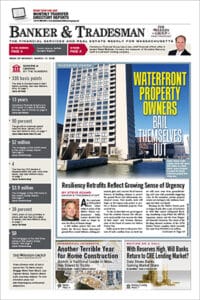
Towers rise around downtown Boston’s Winthrop Square. Photo by James Sanna | Banker & Tradesman Staff
The local real estate markets may be a lot less busy now than a few years ago, but that didn’t mean this summer was a snooze-fest of real estate news.
Here’s a rundown on the six biggest stories you might have missed between vacations, long weekends and what felt like an interminable wait for the Fed to start opening up to the idea of interest rate cuts.
Downtown Drama
The future of downtown Boston office real estate remains as unsettled as ever. Second-quarter data Colliers released early this summer shows the overall availability rate for office properties in downtown and the areas around North and South stations hit 27.36 percent, and that picture could be shaken up further if state officials follow through on plans to seek new, upgraded office environments for state agencies that collectively lease around 800,000 square feet of space downtown in leases set to expire this year or next. And Greater Boston’s suburban office market is starting to draw more office tenants than downtown thanks to declining rents and tenants’ hope for shorter commute times.
Meanwhile, owners of class B buildings are staring hard at a deadline to start investing in decarbonized HVAC and other systems or start paying fines to the city – something experts say is hardly an appealing choice given falling property values and cash-flow problems.
Speaking of falling property values, Boston Mayor Michelle Wu’s proposed commercial property tax rate increase appeared to be one of several high-profile bills to die on Beacon Hill when the traditional end-of-formal-session deadline on July 31 came and went. And a last-minute deal worked out by House Ways and Means Chair – and Wu ally – Aaron Michelwitz appeared to fall flat after the mayor’s attempt to turn up the political pressure on Senate Majority Leader Karen Spilka very publicly failed. But with Wu’s support critical to get a New England Revolution stadium included in the still-in-limbo economic development bill and some months left until the House and Senate formally dissolve their current sessions, this is one story that might yet rear its head in the fall.
If there was any bright spot in the downtown Boston office market this summer, while no organized solution has emerged to the neighborhood’s problems, city and state officials announced a $15 million deal that extended local office conversion incentives and added state aid for such projects. And the slow march of office-to-anything-else conversions continued with projects being filed in Downtown Crossing and in Fort Point.
Big Housing Bill, Big Rent Hikes
One bill Beacon Hill didn’t let whither on the vine amid House-Senate tensions: Gov. Maura Healey’s big affordable housing finance and policy bill, the Affordable Homes Act. The measure legalized accessory dwelling units on many single-family lots statewide, among other policy changes, and includes a “momentum fund” that will help get a select few, big mixed-income projects off the drawing board and into the ground in the next year or two.
But the measure came as new housing construction in Boston itself hit a low not seen since the region was staggering out of the Great Recession and rents hit an all-time high. While a pulse of new supply coming on the market this year may help moderate rents temporarily, two of the region’s bigger corporate landlords told investors that they raised rents substantially in recent months due to housing supply shortages, and expect to be able to keep doing that in the years to come.

The planned lab tower at 15 McGrath Highway in Somerville. Image courtesy of SGA
Lab Market Stumbles Further
As July opened, the development teams behind three separate Somerville lab towers hit the brakes, with the highest-profile being the former Sav-More Liquors site at 15 McGrath Highway. Lab vacancies in the 5.5 million-square-foot inner suburban submarket, which includes Somerville, hit 41.5 percent in the first quarter, according to research by brokerage Colliers.
Across town in the Seaport, developers of spec lab space felt a big blow when the neighborhood’s biggest biotech, Vertex Pharmaceuticals, elected to stay in its Fan Pier headquarters instead of moving the 1.1 million-square-foot office somewhere else, like Boston Global Investors’ nearly-complete, speculative 518,500-square-foot 10 World Trade tower and BioMed Realty’s empty 492,000-square-foot Seaport Science Center at 601 Congress St., or planned-but-not-built projects like Marcus Partners’ approved, 742,000-square-foot lab complex at 310 Northern Ave., Lincoln Property Co.’s approved 650,000-square-foot Seaport Circle tower and an in-permitting expansion of Beacon Capital’s South Boston Innovation Campus at 2 Harbor St.
A rebound in venture capital funding for Boston-area biotechs has some hoping that the mid-stage companies whose expansion fueled the most recent lab space boom could be headed for growth again, albeit growth of a much more moderate type.
Jemison Heads to Detroit
Most staff and functions of the Boston Planning & Development Agency were officially moved under formal city control this summer – a move some advocates grouse amounts to little more than another rebrand, given successive Boston mayors’ longtime dominance of the quasi-public agency – but the biggest change on the ninth floor of Boston City Hall was BPDA Director and Chief of Planning Arthur Jemison’s announcement that he’ll be leaving the city Sept. 13 to return to Detroit, in order to be closer to family.
Major players in the Boston commercial real estate scene praised Jemison as a consummate consensus-builder with “empathy and class” that helped ease tensions between a development community, neighborhood groups and a mayoral administration that have felt increasingly at odds with each other.
But Jemison leaves a lot unfinished, including a series of zoning studies aimed at allowing more development in the city’s neighborhood commercial nodes and a reworking of the city’s unpredictable and lengthy Article 80 development review process that was initially billed as an attempt to make the process more predictable for the real estate industry.

The Davis Cos. told state environmental regulators it wants to build 4.4 million square feet of office, lab, industrial and retail space plus 2.8 million square feet of housing on the site of a former fuel tank farm. Image courtesy of The Davis Cos.
Big Developments in the Offing
From a 40-story residential-and-hotel tower near North Station from The RMR Group to a housing-heavy 5.8 million-square-foot reimagining of Gillette’s factory campus in South Boston to The Davis Cos.’ new plans to replace a 100-acre ex-fuel tank farm in Everett with advanced manufacturing, life sciences and 3,200 housing units, it was clear that at least a few players in the Boston market aren’t letting the current interest rate environment keep them from dreaming big this summer.
The project that caught our readers’ attention the most, though, was B&T’s scoop that the MBTA would offer its Alewife Station at the Red Line’s northern tip for development. The T is still some distance away from selecting a developer, much less revealing finalists, but the project will nonetheless be a test case for a new approach to its real estate that will hopefully lead to more building and fewer projects that never get out of the ground thanks to bureaucratic delays.
Housing Market Sees Disruption
The interest rate lock-in effect continued to dominate the state’s many residential real estate markets this summer, and might be putting a damper on new luxury developments in the city for a while.
Still, not everything was waiting and watching: Lamacchia Realty concluded its year-long campaign to gain footholds in every market statewide with its purchase of a prominent Berkshires brokerage, and long-awaited changes to agent commission structures took effect last month, albeit without much clarity on how homebuyers will find the money to pay their agents. That’s a void Arlington’s Leader Bank said it’s hoping to fill, while gaining market share, by letting buyers finance their commissions with a specialized HELOC.






